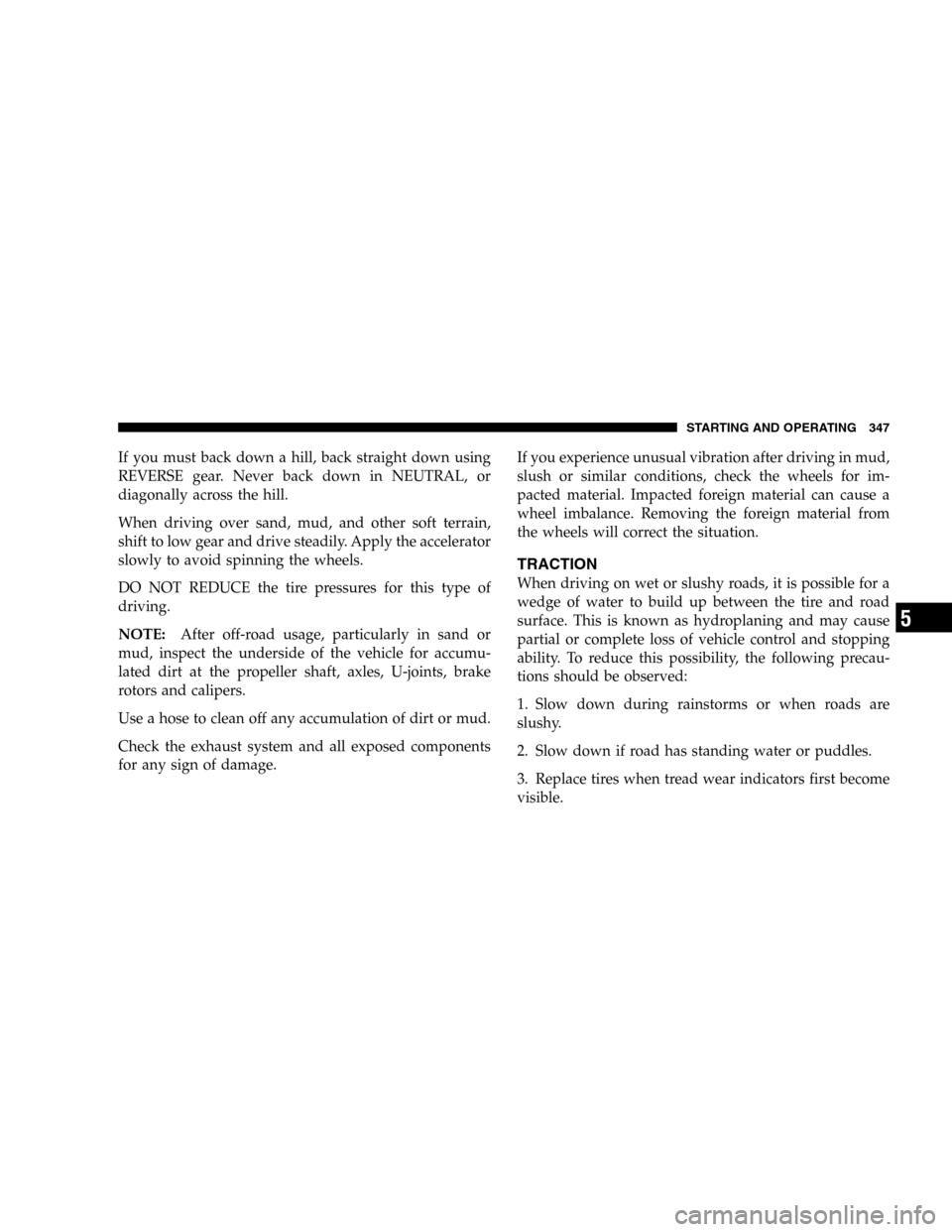Page 327 of 493
Never exceed the maximum tongue weight stamped on
your bumper or trailer hitch.Consider the following items when computing the
weight on the rear axle of the vehicle:
•The tongue weight of the trailer.
•The weight of any other type of cargo or equipment
put in or on your vehicle.
•The weight of the driver and all passengers.
NOTE:Remember that everything put into or on the
trailer adds to the load on your vehicle. Also, additional
factory-installed options, or dealer-installed options,
must be considered as part of the total load on your
vehicle. Refer to the Tire and Loading Information plac-
ard in the Tire Safety Information Section of this manual.
STARTING AND OPERATING 327
5
Page 347 of 493

If you must back down a hill, back straight down using
REVERSE gear. Never back down in NEUTRAL, or
diagonally across the hill.
When driving over sand, mud, and other soft terrain,
shift to low gear and drive steadily. Apply the accelerator
slowly to avoid spinning the wheels.
DO NOT REDUCE the tire pressures for this type of
driving.
NOTE:After off-road usage, particularly in sand or
mud, inspect the underside of the vehicle for accumu-
lated dirt at the propeller shaft, axles, U-joints, brake
rotors and calipers.
Use a hose to clean off any accumulation of dirt or mud.
Check the exhaust system and all exposed components
for any sign of damage.If you experience unusual vibration after driving in mud,
slush or similar conditions, check the wheels for im-
pacted material. Impacted foreign material can cause a
wheel imbalance. Removing the foreign material from
the wheels will correct the situation.
TRACTION
When driving on wet or slushy roads, it is possible for a
wedge of water to build up between the tire and road
surface. This is known as hydroplaning and may cause
partial or complete loss of vehicle control and stopping
ability. To reduce this possibility, the following precau-
tions should be observed:
1. Slow down during rainstorms or when roads are
slushy.
2. Slow down if road has standing water or puddles.
3. Replace tires when tread wear indicators first become
visible.
STARTING AND OPERATING 347
5
Page 362 of 493

wheel. The nuts should then be tightened to recom-
mended torque. Tighten the nuts to final torque in
increments. Progress around the bolt circle, tightening
the nut opposite to the nut just previously tightened until
final torque is achieved. Recommended torques are
shown in the following chart.
Disc
WheelsType Nut Stud Size Torque
Ft. Lbs.Torque
Newton
Meters
Cone 9/16-18 120-150 160-200
Flanged 9/16-18 130-160 190-220
To Stow The Flat Or Spare
Turn the wheel so that the valve stem is down. Slide the
wheel retainer through the center of the wheel and
position it properly across the wheel opening.
For convenience in checking the spare tire inflation, stow
with the valve stem toward the rear of the vehicle.Attach the wheel wrench to the extension tube. Rotate the
winch mechanism until the wheel is drawn into place
against the underside of the vehicle. Continue to rotate
until you feel the winch mechanism slip or click 3 or 4
times. It cannot be overtightened. Push against the tire
several times to be sure it is firmly in place.
HOISTING
A conventional floor jack may be used at the jacking
locations, refer to the graphics that show jacking loca-
tions. However, a floor jack or frame hoist must never be
used on any other parts or the underbody.
CAUTION!
Never use a floor jack directly under the differential
housing of a loaded truck or damage to your vehicle
may result.
362 WHAT TO DO IN EMERGENCIES
Page 397 of 493

WARNING!
Exhaust gases can injure or kill. They contain carbon
monoxide (CO) which is colorless and odorless.
Breathing it can make you unconscious and can
eventually poison you. To avoid breathing CO, fol-
low the preceding safety tips.
Exhaust System Rubber Isolator and Loop-Type
Hanger — If Equipped
Inspect surfaces whenever the vehicle is hoisted for
rubber to metal separation or deep cracks. If, however,
excessively deep localized cracks are present, or any part
of the exhaust system abnormally contacts the under-
body hardware, the isolator and/or hanger should be
replaced.
Cooling System
Cooling System Maintenance
At the intervals shown in the Maintenance Schedules
Section of the manual, the system should be drained,
flushed and filled.
Inspection
Check engine coolant (antifreeze) protection every 12
months (before the onset of freezing weather, where
applicable). If coolant is dirty in appearance, the system
should be drained, flushed and refilled with fresh coolant
as specified.
Inspect the entire cooling system for leaks. Check the face
of the radiator for any accumulation of bugs, leaves, or
other foreign matter. If dirty, clean the radiator core with
a garden hose. With the engine OFF, gently spray water
from the back of the radiator core. Check coolant bottle
tube for condition and tightness of connections at coolant
bottle and radiator.
MAINTAINING YOUR VEHICLE 397
7
Page 478 of 493

Air Cleaner, Engine (Engine Air Cleaner Filter) . 385,412
Air Conditioner Maintenance............... 391
Air Conditioning Refrigerant.............391,392
Air Conditioning System................234,391
Air Conditioning System, Zone Control........ 238
Air Filter.............................. 385
Air Pressure, Tires....................301,309
Airbag..............................43,49
Airbag Light.........................72,178
Airbag On/Off Switch..................... 49
Airbag, Side............................ 52
Alarm, Out of Park Sense.................. 271
Alarm (Security Alarm).................26,180
Alignment and Balance................... 308
Alterations/Modifications, Vehicle............. 7
Antenna, Satellite Radio................... 227
Antifreeze (Engine Coolant)................ 400
Capacities........................... 437
Anti-Lock Warning Light...............182,290Anti-Theft System.....................26,180
Appearance Care........................ 416
Ashtray............................... 152
Automatic Transmission................... 407
Adding Fluid......................... 407
Fluid and Filter Changes................. 408
Fluid Level Check...................... 407
Fluid Type........................408,439
Shift Indicator........................ 180
Shifting............................. 266
Special Additives...................... 409
Axle Fluid..........................406,439
Axle Lubrication (Axle Fluid)............... 406
Ball Joints............................. 393
Battery............................... 390
Blanket..........................261,391
Emergency Starting..................... 363
Saving Feature (Protection)............... 121
478 INDEX